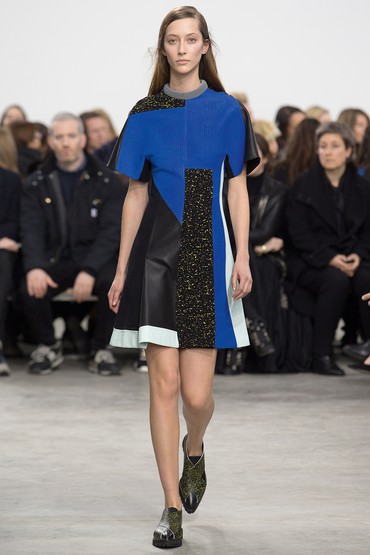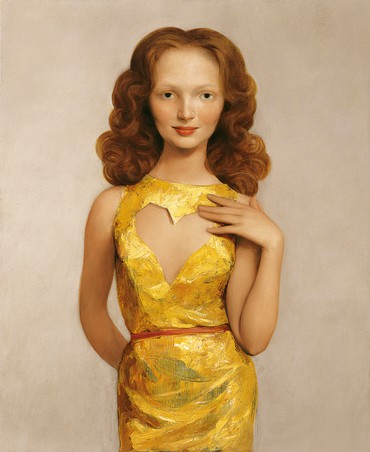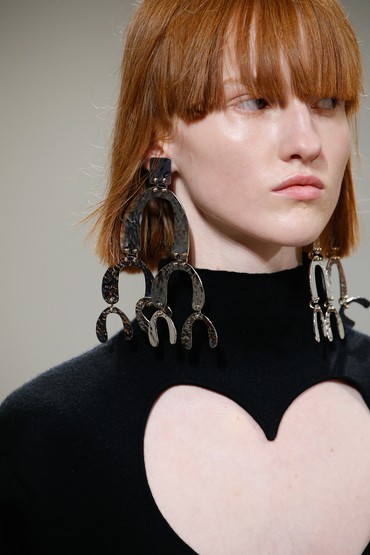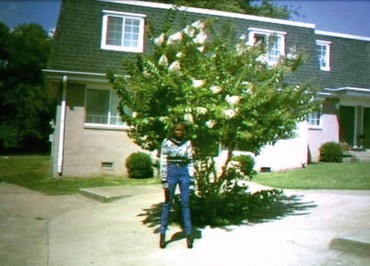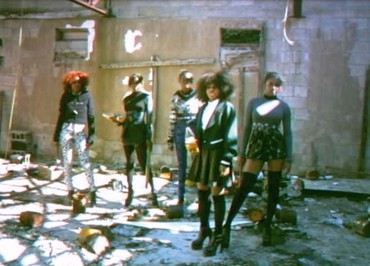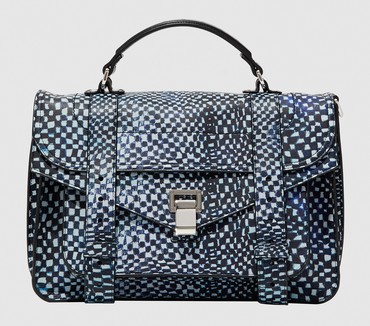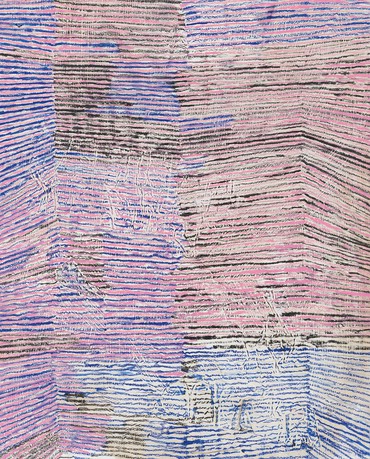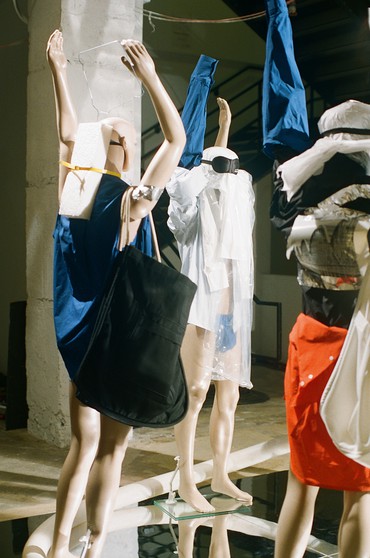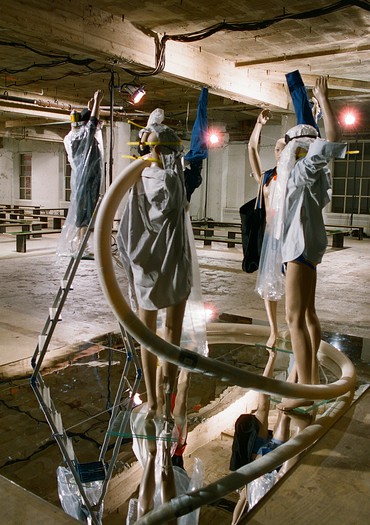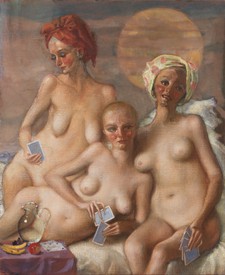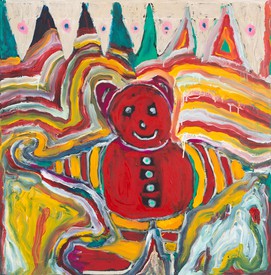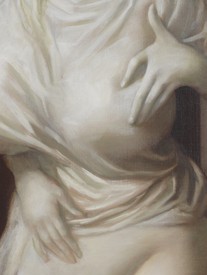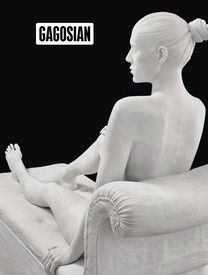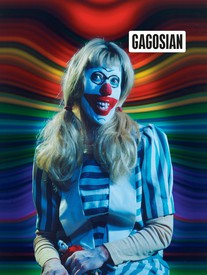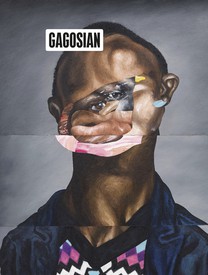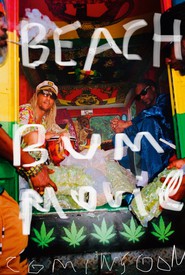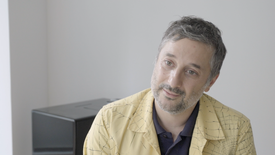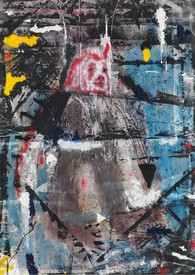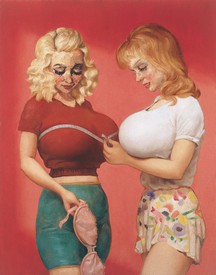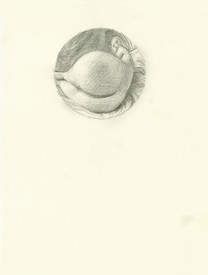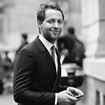
Derek Blasberg is a writer, fashion editor, and New York Times best-selling author. He has been with Gagosian since 2014, and is currently the executive editor of Gagosian Quarterly.
Derek Blasberg I see images of Mark Rothko paintings pinned on the wall in the studio. Talk to me about how the two of you research artists and how you agree on what direction to take. Do you guys ever fight over which artist, which picture, which painting?
Jack McCollough We’re in the thick of that right now. We’re just gathering information, I’m gathering sources and Lazaro is gathering sources. We both take stacks of images—that’s what you see up on the wall right now—and we sift through research, research, research, so many images. And as we sift, that starts to form a dialogue. There’s never one specific thing that gets a collection going. There are two of us, so it’s always a mix of our ideas coming together and, hopefully, creating something greater. Also hopefully, the sources blur and become abstract, so in the end you can’t put your finger on a single thing.
Lazaro Hernandez We go to museums and galleries and look at books that friends send us—the traditional places to find inspiration, of course. Last season we were doing a lot of sharp lines, very ’80s, with a lot of edges. But this season, looking at the Rothkos, it feels like the edges should be softer and blend more. I went by myself to the Met a few weeks ago to see the Epic Abstraction show, and there’s a room of Rothko paintings. I looked at some of the edges and came home and said, “Oh, Jack, Rothko’s interesting. I’m into those lines and the line quality.” And he pulled out some Sigmar Polke images that had a diffused quality too. And we had our starting point.
DB How long have you two worked together?
JMcC We started the company in 2004.
LH Can you believe that?
DB It’s incredible because it feels like yesterday. How has your process changed in the last decade and a half?
JMcC It’s evolved. In some ways we still work the same way we did in the very beginning. We’re very analog. We do all of the research and then go to our place in the Berkshires, sit at a long table, and sketch for ten days, twelve hours a day. That’s old school.
LH That’s the place to get our creative work done. New York is where we’re dealing with meetings and our teams and the business side of things. But in terms of the creative side, the country is where we can go hear our thoughts, hear our ideas, and not have the distractions of the outside world.
JMcC Our sketches riff off each other. Maybe I’ll draw a collar detail, and then Lazaro will see that and he’ll riff off that and he’ll do a jacket. Back and forth and then at the end of the ten days we’ve got this huge stack of drawings and start the editing process. It’s almost like a storyboard and we build it all out. What does the beginning look like? How does it evolve? Does it get more built up or does it disintegrate as the show evolves? That’s our blueprint for the season. Then we split apart again and I’ll fit the things I drew and Lazaro fits the things he’s drawn. We put it all together in the end, during the show process.
There’s never one specific thing that gets a collection going. There are two of us, so it’s always a mix of our ideas coming together, which, hopefully, is creating something greater.
Jack McCollough
LH Sometimes it’s very verbatim. Some looks are exactly as drawn, and then sometimes the drawing doesn’t work in real life and in the fitting it becomes something else.
DB I recently wrote a piece on Cindy Sherman and she said that she had tried to hire assistants in the past, but she ultimately felt like when she had a team she was forcing herself to work more, to look busy in front of them. It’s interesting that you get most of your work done alone.
LH We’re leaving on Monday for the country to start working on the show. Just me and Jack locked up in our studio for a week.
JMcC But then we come back and the team helps us execute the ideas. What we do takes such an army of people to make happen. There’s a lot of production involved with the whole thing. So our creative process, at least where it starts, is just the two of us, but the creative process has different parts.
DB Have you ever worked with an artist who’s given you feedback on your process?
LH Ron Nagle. We saw his work for the first time at the Venice Biennale. We fell in love with the palette, forms, shapes, textures . . . all of it. So we went deep into Nagle. We reached out to say, “We’re really into the work. We hear you live in San Francisco; we’re going to be out there and we’d love to visit you.” He invited us to the studio and when we got there we saw Proenza Schouler advertisements. So he was sort of a fan of ours and we were a fan of his. He agreed to do a shoot with us for W magazine and then we did a whole season based on his work, and it felt like this divine blessing. That was cool.
JMCC John Currin inspired some of our designs too.
LH I once had dinner with him and Rachel Feinstein and we were talking about his painting Heartless [1997]. There’s a girl in a gold dress with the heart cut out. That was the starting point for another show. We had a chat with John and then the entire show sort of shape-shifted around that point.
DB Did you tell him that the painting inspired you?
LH Actually, yes. We asked, “Hey, we have a reproduction of Heartless on the wall. Is it weird if we just copy that on a sweater?” And he said, “I would love that. It’d be so great.”
DB Did you give Rachel one of the sweaters?
JMcC Yes, of course.
LH But you know, the art references are very subtle and they’re very insider-y. We know these artists when they’re alive, usually. We don’t often like looking at vintage fashion as a reference. The world’s much bigger. We’re really into music so we listen to a lot of music, and we go to a lot of shows, we see a lot of art, and that usually finds its way into the collection. Every season there’s some sort of major art reference.
DB How was it to work with Harmony Korine?
JMcC Harmony’s someone we grew up with. Larry Clark’s film Kids [1995], for which he wrote the screenplay, was a hugely influential movie for our entire generation.
We see a lot of art, and that usually finds its way into the collection. Every season there’s some sort of major art reference.
Lazaro Hernandez
LH It was so scary at the time, remember?
JMcC That movie defined our generation in a lot of ways, and we all watched it right before we got to New York. So it was kind of instrumental in our early days here in New York.
LH Harmony defines that New York ’90s thing. He’s kind of the male counterpart to Chloë [Sevigny].
JMcC He did two films for us a few years ago. The process was, we let him do his thing. We gave him carte blanche to create something and recontextualize our collection in a different way. We sent clothes down to Nashville, they did a street casting of girls, and he put this little poetic piece together.
LH That was actually the same year we launched the first PS1 bag.
DB Why was it called PS1?
JMcC Proenza Schouler, the first bag. It was kind of based on a schoolboy’s satchel. We like the school reference. It’s very New York.
LH It’s also a museum. All of those correlations were interesting to us.
DB Have you done a PS2? PS3?
JMcC We’ve done a PS11. And we’ve done a PS19, last season.
LH PS2 is taken because of PlayStation!
DB Ha, that’s fascinating.
LH For the ten-year anniversary project we wanted to collaborate with an artist, and Harmony seemed like the perfect fit. The first time we did an artist collaboration with Harmony was around PS1.
JMcC The Harmony collaboration is our original bag shape but with motifs and patterns sourced from Harmony’s body of work. They’re the paintings that he did for his first show at Gagosian. It’s interesting, we thought we were going to use some of his new images, but we kept going back to that original body of work.
DB Talk to me about Isa Genzken and the installation she did for one of your shows.
LH That was our big coming-back-to-New York show after a year of shows in Paris, and we wanted to do something out of the box for us. So as you came in, there was this huge installation that featured some of our clothes. You came up the elevator and it was there.
DB I remember! Do you think that fashion people understood what they were looking at?
JMcC Honestly? No.
DB Do you care?
LH Not really. Because it was so amazing and we loved it. We went to Berlin and we met Isa and she was up for it, so we sent her early samples that we created. We didn’t know what she was going to do at all. At one point she went missing. We didn’t hear from her. It was getting down to the wire, just before the show, and we were wondering, “Did she forget?” And then a week before the show she sent images of the entire installation and we loved it. Even if we had to figure out how to ship it to New York in time for the show.
JMcC That was less of a collaboration and more of a conversation. You know, we sent her clothes that she then made a piece with, and then we took that piece, riffed on it, and built those ideas into the collection. It was more of a conversation than her making clothes for the actual collection.
LH There’s no commercial product.
JMcC It seems like more of a modern way of collaborating.
LH There was no Isa Genzken T-shirt. It was literally an art piece that we premiered at the show.
DB And where is it now?
JMcC She took it back; she wanted to build on it even more.
LH It sold for millions of dollars, I’m sure!
DB Did she get to keep the clothes?
LH Yeah. They’re part of the work now. They’re part of the mannequins. It’s amazing. The clothes are the work.
DB Why do you think it’s important to have an element of contemporary art in your fashion-show experience or in your world?
LH To be original. It’s important to have your actual interests as part of the dialogue. Fashion is superpersonal. We’re creating fashion, not for a legacy house but for our own house.
JMcC That’s the big difference. We’re not working for a heritage brand with all these codes to pull from. We’ve made this up from scratch all ourselves. In a lot of ways, what we do is autobiographical.
LH And one of our biggest interests in life is art. It’s really natural for us, we’re looking at it all the time.
DB Do you think the people who wear your clothes understand art?
LH No, but I think they see stuff like that and are like, “Oh, is it cool?” It’s New York, it’s alternative, you know? So it’s artistic.
DB Do you feel that in some way you’re helping to educate your consumers? Introducing them to ideas they maybe didn’t know about before?
LH With context it becomes fashion. It’s interesting to populate the narrative of the brand.
JMcC Also, for what it’s worth, we’re doing it for selfish reasons. The fashion cycle is so relentless. It’s a hamster wheel. It’s like season after season after season. So to do these collaborations and interact with people outside our field keeps it interesting for us—it keeps us energized.
DB Have any of the artists you’ve worked with been upset by what they’ve inspired in your designs?
LH No, but one time we were worried. After the Cy Twombly collection . . .
JMcC In 2006 we won the CFDA [Council of Fashion Designers of America] Award and Chloë wore a dress inspired by Cy Twombly. And the day after the awards, we got a call from Larry Gagosian’s office.
LH Our CEO at the time came in and said, “Larry Gagosian’s office just called.” We thought for sure it was a lawsuit or a cease-and-desist.
JMcC But he ended up just wanting to buy one of the dresses for a friend.
LH Which was a relief.

